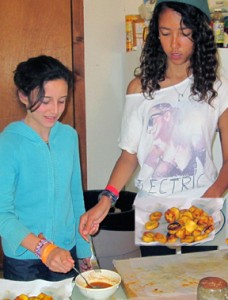Some Jewish books belong on every shelf, and Too Good To Passover by Jennifer Abadi is one. This impressive work brings together recipes, traditions, and personal stories capturing a wide range of Jewish practices and history from around the Sephardic and Judeo-Arabic world. And for anyone who wants to deepen their understanding of the Jewish world and expand their Jewish palate, this book is a must-have.
Abadi did not start out planning to be a chef, let alone a storyteller. A plan to create an art portfolio brought her into her grandmother Fritzie’s Syrian kitchen, which led to the publication of her first cookbook, A Fistfull of Lentils. From there, she began to explore the world of Jewish food and found that there was a genuine interest in the foods of Jews from Africa, Asia and Sephardic Europe. “Whenever I did a class about Mediterranean food or Sephardi food, the classes would sell out right away.”
Many of the communities represented in this book have largely migrated to other countries. Abadi is sensitive to how food and memory continue the connection over the generations. “Foods fall out of fashion; you can’t always get ingredients; things change,” she explains. Abadi preserves the connection by writing down the stories and memories of the people who cooked these dishes and the places from which they came.
Divided by continent and then country, each section of the book begins with how the Seder plate is laid out in the tradition of that particular Jewish community. Abadi herself drew the illustrations, and when they are compared side by side, it is immediately apparent how different Jewish communities have interpreted something as basic as the Seder plate in their own unique ways. Even matzah, which by the strictures of Jewish law is limited in ingredients, just flour, and water baked in under 18 minutes, can take on distinct characteristics. Monique Sasson of Italy, explains in the book until very recently, Italian Jews would go to the synagogue to pick up special flour, “the quality of this flour was much finer and silkier in texture than everyday flour, and very white in color.” Then they would bring it home and make their own matzah.
In addition to better-known communities, like those from Syria, Iraq, Italy, North Africa, Greece, and Turkey, Abadi searched far and wide to find material from the Balkans, Afghanistan, Ethiopia, and India. In these pages, Helou Jozz el’Hind, a coconut candy sweet with almond and orange blossoms from Syria and Lebanon, fits in comfortably with Lybian Ruz b’il Hud’arah, spicy rice with tomatoes, celery, and dill as well as Shaweey’yeh a Yemenite meat stew with mint, coriander, and garlic. One can make a whole themed Seder based on a particular country or bring in dishes from a region. Each dish provides a chance to explore the Jewish world.
As a child, there were times when Abadi’s immediate family would celebrate the Seder with her extended maternal Syrian side in Brooklyn. Syrian tradition meant that the men sat around the table and performed the rituals while the women gathered in the kitchen and served food.
Seders in their own home in Manhattan were a more mixed culinary affair. Abadi’s father was from Riga, in modern-day Latvia. There were Ashkenazi influences at their egalitarian Seder. “Matzo ball soup is a must for my family,” Abadi explains.
She encourages people to experiment at Passover. The book has recipes for the Seder and for the weekdays of Passover as well. The recipes are accessible and reliable, giving clear instructions for how to use ingredients that may be unfamiliar to some.
And if you are hesitant to move away from the dishes that have always been part of your family’s Passover Seder, Abadi recommends trying out some of the charoset recipes from around the world, Too Good to Passover has 18 different options.
Algerian Style Haroset (Fig and Date “Truffles” with Hazelnuts, Walnuts, and Pear)
Yield: Serves 10 to 12
INGREDIENTS:
½ cup walnuts
½ cup whole raw almonds
½ cup hazelnuts
1 to 2 tablespoons sugar (optional or to taste)
5 ounces Medjool dates (about 7 large or 14 regular dates), pitted and cut in half
4 large dried Black Mission figs, stems discarded, cut in half
4 teaspoons finely chopped ginger root
½ cup Bosc pear cubes
2 tablespoons sweet kosher wine
1/3 coarsely grated green or red apple, with or without skin
1 to 2 tablespoons water (as needed)
EQUIPMENT:
Measuring cups and spoons
Mixing bowl and spoon
Food processor
Recipe Procedure:
1. Place the walnuts, almonds, hazelnuts, and sugar in a food processor and pulse until coarsely ground, but not yet a meal-like consistency (about 30 seconds).
2. Add the dates, figs, ginger root, and pear and pulse again until a thick paste is formed.
3. Add the wine and a little water to make the mixture smooth and spreadable.
4. Scoop out into a mixing bowl and mix in the grated apple with a spoon.
5. Serve at room temperature stacked in a small decorative bowl or on a small platter alongside tea matzahs. Store in an air-tight container in the refrigerator for up to three days, or the freezer for up to one month.









